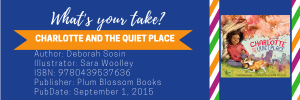by Seemi Aziz, University of Arizona, Tucson, AZ, and Melissa Wilson, Leeds Trinity University, Leeds, West Yorkshire, UK
Rounding off the first month of 2021, we discuss Charlotte and the Quiet Place and take one last look at how mindfulness may help us during this stressful times.
The texts discussed this month may offer readers (and listeners) some peace during these most turbulent times. They are books that thematically deal with the concept of mindfulness through a narrative. There are many new books being marketed for children that are guides to mindfulness practices. A quick browse on Amazon yields pages of “activity books” that offer to help children process feelings, step-by-step manuals for doing meditation with children, and even books to help teach children “growth mindsets”.
Sometimes the best way to deal with a difficult present and an uncertain future is to lose yourself in someone else’s story. Through reading, or being read to, you can experience different ways of living on a deep level. These experiences can give much succor and “practice runs” at figuring out how to live a life well.
Charlotte is a girl who seeks a quiet place where she can think and reflect. Wherever she goes she finds noise that is chaotic for her. To her surprise she finds the peace inside of herself.
SEEMI: I appreciated the concept of self-help and looking within to find peace and solace, that the narrative portrayed. I also loved the beautiful artwork and the simplicity of the written text. What I did not appreciate was the choice of an African American main character who lives in a busy, dated, and somewhat dingy neighborhood. I may be reading too much between the lines within the text but knowing that the author and the illustrator are White women made me think about this. I do believe that anyone has the right to write stories and the message in this one was very appropriate, but I sensed racist undertones as I read through this text. I recommend The Sound of Silence by Katrina Goldsaito & Julia Kuo (2016) a story with the same theme as the book we have discussed here.
MELISSA: Interesting point, Seemi! I, too, was interested as to why the protagonist is African-American. I found an interview with Deborah Sosin, which addresses our concerns. This is what the author says:
DS: I imagined Charlotte as a little version of me—growing up in suburbia in the 1950s. Then Rachel suggested an urban environment, and to have Charlotte be African-American. I wasn’t sure about it in the beginning because I’d have to give up my original vision, and I worried about cultural appropriation and such [as a white author], but it ended up being a good thing. I learned pretty quickly that this was important; even though I’m a white author, that there is a huge need for books with “casual minority protagonists,” that is, kids of color whose stories don’t relate to a racial or cultural subject, such as slavery or civil rights, or oppression—the topic is just universal.
Rachel, who suggested that Charlotte be in an urban environment and African-American, was Rachel Neumann, who was the marketing director at Parallax Press, the original publisher of the book. It seems as if Charlotte became a NYC person of color because that could sell more books. Both the author and the illustrator are from suburban Massachusetts and are clearly working outside of their own cultures. I found the illustrations to be out of time and place- they harkened back to “urban (read black and brown) America in the 1970s”, with their bright colors and undulating grounds. The iconography is cliched; there are subway cars and delis, Ray’s pizza, and I heart NY signs. Nothing that suggests an actual relationship with NYC.
However, this MTYT is also about mindfulness. This text, despite its many flaws, does a good job with helping people to understand how to slow down and just be amid a busy crazy world. When Charlotte finds her quiet place, it’s described as “a place as quiet as the small silence on the very last page of her favorite book, the silence right after ‘The End'”. That line was evocative to me. I know that feeling and want it. It may convince me to mediate yet!
Title: Charlotte and the Quiet Place
Author: Deborah Sosin
Illustrator: Sara Wolley
ISBN: 9780439537636
Publisher: Plum Blossom Books
PubDate: September 1, 2015
Throughout January 2021, Seemi Aziz and Melissa Wilson look at picturebooks that explore mindfulness to children. Check back each Wednesday to follow the conversation!
- Themes: Charlotte and the Quiet Place, Deborah Sosin, Melissa Wilson, Sara Woolley, Seemi Aziz
- Descriptors: Books & Resources, My Take/Your Take

